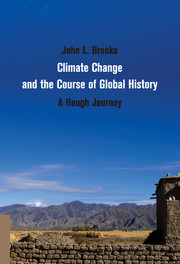Book contents
- Frontmatter
- Dedication
- Contents
- List of Figures and Tables
- Acknowledgments
- List of Abbreviations
- Introduction
- Part I Evolution and Earth Systems
- Part II Domestication, Agriculture, and the Rise of the State
- Part III Ancient and Medieval Agrarian Societies
- Part IV Into the Modern Condition
- 10 Climate, Demography, Economy, and Polity in the Late Medieval–Early Modern World, 1350–1700
- 11 Global Transformations: Atlantic Origins, 1700–1870
- 12 Launching Modern Growth: 1870 to 1945
- 13 Growth beyond Limits: 1945 to Present
- Coda
- Data Bibliography: Full Citations for Data Used in Figures and Tables
- Index
- References
12 - Launching Modern Growth: 1870 to 1945
Published online by Cambridge University Press: 05 August 2014
- Frontmatter
- Dedication
- Contents
- List of Figures and Tables
- Acknowledgments
- List of Abbreviations
- Introduction
- Part I Evolution and Earth Systems
- Part II Domestication, Agriculture, and the Rise of the State
- Part III Ancient and Medieval Agrarian Societies
- Part IV Into the Modern Condition
- 10 Climate, Demography, Economy, and Polity in the Late Medieval–Early Modern World, 1350–1700
- 11 Global Transformations: Atlantic Origins, 1700–1870
- 12 Launching Modern Growth: 1870 to 1945
- 13 Growth beyond Limits: 1945 to Present
- Coda
- Data Bibliography: Full Citations for Data Used in Figures and Tables
- Index
- References
Summary
Urbanization, a New Political Economy, and the Second Industrial Revolution
The environmental history of the modern world has been shaped by a complex balancing of massively expanding populations, wildly divergent rates of economic growth, and their impacts on the natural world. During these decades, we moved from what the environmental economists call an “empty earth” to a “full earth,” from an earth in which the planetary systems of sources and sinks could manage the somewhat destructive behavior of one of its more successful species, to an earth where this behavior has begun to threaten the sustainability of that species in the earth system.
For our purposes here it is useful to divide the economic history of the modern world into a series of great expansions and interruptions. There have been at least two great expansions, as measured by gross national product, which are – in an unconscious echo of geological terminology – labeled super-cycles (see Table IV.3 and Figures IV.3 and IV.14). The first modern expansion or super-cycle was driven by a “Second Industrial Revolution” in nations around the North Atlantic, and took place from the 1870s to the First World War; the second expansion or super-cycle began after World War II and ended in the 1970s. These great super-cycle expansions were stalled by two “great interruptions,” the era of the world wars and depression of 1914 to 1945, and the era of the great oil and financial crises of 1973 and 1979 through the 1980s, slowing global growth episodically. Despite the recession of 2008, economists are arguing that since roughly the year 2000 we have been at the beginning of a new, third super-cycle driven by the explosive emergence of the Chinese and Indian economies and by complex new trading relationships.
- Type
- Chapter
- Information
- Climate Change and the Course of Global HistoryA Rough Journey, pp. 500 - 528Publisher: Cambridge University PressPrint publication year: 2014



